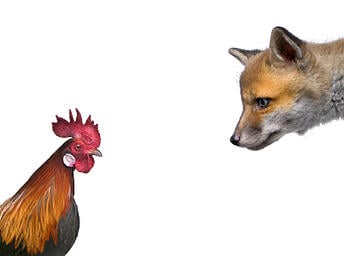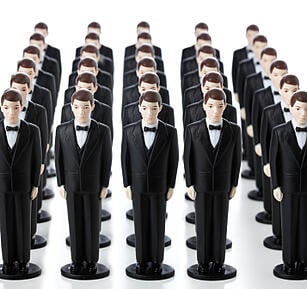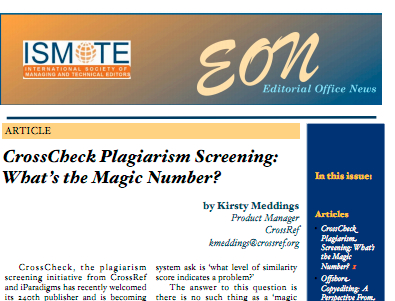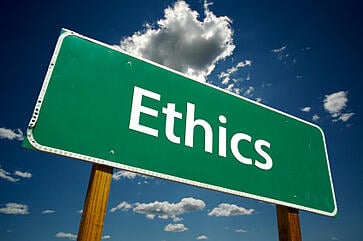Written by Beth Calvano

Read the most up-to-date information on the integrity of the research across industries, publishing in top journals, reputation and much more.
Written by Beth Calvano

 Self-plagiarism has been an elusive subject for many. How can one steal material from oneself? Jonah Lehrer is an excellent example of how a writer can fall into this plagiaristic behavior. Mr. Lehrer is a renowned author who has published in Wired, the Wall Street Journal, the New York Times Magazine, the Guardian, the Washington Post, and the New Yorker. He had recently taken a position of staff writer at the New Yorker (Silverman, 2012).
Self-plagiarism has been an elusive subject for many. How can one steal material from oneself? Jonah Lehrer is an excellent example of how a writer can fall into this plagiaristic behavior. Mr. Lehrer is a renowned author who has published in Wired, the Wall Street Journal, the New York Times Magazine, the Guardian, the Washington Post, and the New Yorker. He had recently taken a position of staff writer at the New Yorker (Silverman, 2012).
 The recent copyright suit brought against startup Boundless Learning by three major textbook publishers, Pearson, Cengage, and Macmillan Higher Ed serves as occasion, yet again, to revisit key themes that surface each time the narrative of education’s disruption by technology – especially via web-based innovations – is rehearsed. The suit came shortly after the announcement of an $8 million investment in Boundless, led by VC-firm, Venrock. Intriguingly, the suit also appears to attack the investors as well, underscoring the business opportunity (and loss thereof) that seems to obtain with any discussion that involves the Internet, new technology, and “disruption.” The second theme that we see is the well-worn “David vs. Goliath” story, and the last is the same story of education’s revolution at the hands of a web-based alternative.
The recent copyright suit brought against startup Boundless Learning by three major textbook publishers, Pearson, Cengage, and Macmillan Higher Ed serves as occasion, yet again, to revisit key themes that surface each time the narrative of education’s disruption by technology – especially via web-based innovations – is rehearsed. The suit came shortly after the announcement of an $8 million investment in Boundless, led by VC-firm, Venrock. Intriguingly, the suit also appears to attack the investors as well, underscoring the business opportunity (and loss thereof) that seems to obtain with any discussion that involves the Internet, new technology, and “disruption.” The second theme that we see is the well-worn “David vs. Goliath” story, and the last is the same story of education’s revolution at the hands of a web-based alternative.
Journalists and bloggers seem to be at the forefront of the fight against literary plagiarism it seems. With the recent exposure of several high profile and respected authors and the shock felt about this in the literary world, a watershed has been reached. Hodder & Stoughton’s statement on one notorious case involving Q.R. Markham (the pen name of bookseller Quentin Rowan) set a benchmark for others in the publishing industry:
"We deeply regret having acquired a book for our list that we can no longer accept as an original work, and in partnership with Little, Brown we have acted immediately to recall the book from distributors and retailers."
 Written by Eric Hoppe, Account Manager, Constant Content. Plagiarism has existed nearly as long as the written word itself, but it has never been easier for plagiarists to cut and paste some else’s words and claim them as their own. That can be a big problem for webmasters in search of quality website content and article writers for their websites, blogs and online stores. Webmasters know that they need to rank high in search engine results in order to compete. They also know that Google and other popular search engines take a dim view of duplicate content. Webmasters who buy articles they believe are original content can be in for an unpleasant, and dangerous, surprise when Google slaps them with a duplicate content penalty and buries their sites at the bottom of the rankings.
Written by Eric Hoppe, Account Manager, Constant Content. Plagiarism has existed nearly as long as the written word itself, but it has never been easier for plagiarists to cut and paste some else’s words and claim them as their own. That can be a big problem for webmasters in search of quality website content and article writers for their websites, blogs and online stores. Webmasters know that they need to rank high in search engine results in order to compete. They also know that Google and other popular search engines take a dim view of duplicate content. Webmasters who buy articles they believe are original content can be in for an unpleasant, and dangerous, surprise when Google slaps them with a duplicate content penalty and buries their sites at the bottom of the rankings.
Written by Kirsty Meddings, Product Manager at CrossRef ---CrossCheck, the plagiarism screening initiative from CrossRef and iParadigms has recently welcomed its 240th publisher and is becoming an established part of the  editorial process for many journals. CrossCheck members use the iThenticate plagiarism detection system to screen submitted papers for originality and can quickly tell whether a paper contains passages of text that also appear in other publications or resources.
editorial process for many journals. CrossCheck members use the iThenticate plagiarism detection system to screen submitted papers for originality and can quickly tell whether a paper contains passages of text that also appear in other publications or resources.
Written by Jonathan Bailey, copyright and plagiarism consultant with CopyByte and author of PlagiarismToday. Since Jessica last talked about this case, Johann Hari, a columnist and interviewer for Britain’s “The Independent” has been forced to watch as the allegations against him deepen and the damage to his reputation and his paper’s grows by the day. According to readers, Hari took quotes from other sources and presented them as if they were things said in his interviews.
Since Jessica last talked about this case, Johann Hari, a columnist and interviewer for Britain’s “The Independent” has been forced to watch as the allegations against him deepen and the damage to his reputation and his paper’s grows by the day. According to readers, Hari took quotes from other sources and presented them as if they were things said in his interviews.
Though Hari didn’t claim other’s words as his own, over the past few weeks Hari has been suspended from the paper pending an internal investigation, which is expected to take two months, and has already had his prestigious George Orwell prize revoked.
Whether or not the scandal rises to the level of plagiarism, something Hari denies even in his apologies, it’s clear that it has brought a great deal of disrepute both to his name and a good deal of headache to The Independent, all at a time when British journalism is already reeling from other, much larger scandals.
However, the entire incident could have been easily avoided. Technology exists already that can detect these kinds of reuses and give businesses a chance to correct these problems before they become issues “in the wild”.
Despite this, most companies don’t take advantage of these tools. Fearing either high costs or employee backlash. But as the Hari case proves, there’s a lot to be risked by not taking preventative steps and, sadly, it’s not just newspapers and magazines that need to be concerned.
More Than Just Plagiarism Scandals
Though it’s tempting to think plagiarism and copy detection tools are useful solely for detecting plagiarists, it’s far from the case. As the Hari case shows, there’s a wide variety of ways content can be reused that creates problems and, as such, it’s generally worthwhile to detect and prevent duplicate content whenever possible.
Consider just some of the potential problems that can arise from unethically or unlawfully duplicated content:
But while most of the major news stories have centered around print publications and their plagiarism issues, the truth is that all companies need to pay attention to their content and ensure its originality, lest it come back to bite them much harder at a later date.
Mass Media Law and Ethics, Not Just for Journalists
While it is easy to see the importance of content detection for journalism institutions and other publishers, what if your company sells bikes or carpet?
One of the major changes that the Internet has brought to us is that any company, no matter what product they sell or what size they are, has the potential to reach out to a global audience. With that immense power also comes a great deal of responsibility.
After all, the door swings both ways. While well-written original content on your site or in your company newsletter can get you business from all over the world, duplicate content can damage your reputation anywhere that Google can reach or even invite a lawsuit from another country.
To avoid this, you need to be thinking about the dangers before you hit publish and taking steps to prevent and mitigate problems before they arise.
Doing so, fortunately, is very easy but one has to be willing to deal with the potential threat even though no imminent danger may be staring at them.
Dealing with the Threat
Preventing the Web from biting your business means stopping unethical or unlawful duplicate content before it appears online. That, in turn, means addressing the issues beforehand and not waiting until later to deal with the issue.
In general, here are a few steps that every business should take:
If you take these steps, not only will you have fewer problems, but if they do arise they will be less serious and less damaging.
All in all, this is truly a situation where an ounce of prevention is worth many pounds of cure.
Bottom Line
Almost certainly, “The Independent” could have avoided much of its current headache and problems if it had been checking Hari’s work along and along. They might have spotted the issue and been able to raise it with him in private, both sparing his career and the paper the reputation damage.
That, in turn, is one of the most important things to remember about these issues. Addressing them in the workplace might seem like you’re creating a hostile situation with your employees and coworkers, but such a system can just as easily help them as well and often does.
After all, for every scandal that’s damaged a company, there have been many that were narrowly avoided, detected by software or eagle-eyed editors, and corrected to ensure one mistake doesn’t sink a company or ruin a career.
In short, if done well, addressing these issues early helps everyone, not just the bottom line.
© 2025 Turnitin, LLC. All rights reserved.